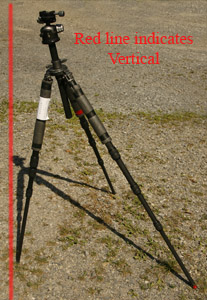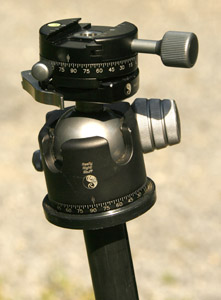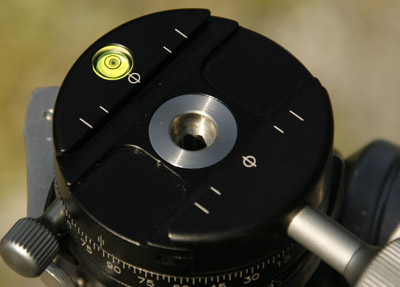
This is not a breath-taking panorama, but wait until you see the position of the tripod
when I took these three images! My tripod was anything but level.

 One
of the requirements of making a good panorama shot is to have
a level pan as you move from one shot to the next. Achieving a
level pan can be done in several ways. In our PDF book, Digital
Nature Photography, From Capture to Output, we discussed the use
of levels, including an inexpensive key-chain level that can simply
be rested upon a hotshoe mount.
One
of the requirements of making a good panorama shot is to have
a level pan as you move from one shot to the next. Achieving a
level pan can be done in several ways. In our PDF book, Digital
Nature Photography, From Capture to Output, we discussed the use
of levels, including an inexpensive key-chain level that can simply
be rested upon a hotshoe mount.
Checking for levelness is the easy part; the more difficult is to actually get a camera level, and to keep that same degree of levelness throughout a pan. In the image on the right I really exaggerated a tilted camera, extending one leg much further than the others. You can see the pitch with the reference red line.
Now, granted, I've set my tripod on a flat surface so my angle is exaggerated, but I could easily have had a similar disparity of leg length if I was shooting on a steep hillside. Either way, getting a level camera could be very difficult and would require using a camera level and a ballhead which I'd have to tilt this way or that to get the camera level. Unfortunately, a level camera would require a fixed position, since moving the camera left or right, in a pan, would have changed the angle of the ball head that helped me to achieve a level position in the first place.
On 'normal' ground, basically a fairly level surface, it's much easier to achieve a level camera for a panorama. To do so, I first adjust my tripod legs so that the tripod head platform is level. My Gitzo tripod has a bubble level in the head platform area (where you would screw on a ballhead) that indicates when that area is level. Then, with a ballhead, I can level the camera atop this leveled surface. To achieve a level tripod position, however, requires some rather tedious tripod leg work, where I'll have to tilt the tripod in different directions to get a feel for how long I'll have to extend each tripod leg. This can take minutes.
There is a better way.
 The
Really Right Stuff company has a panning clamp that can attach
directly to a traditional Arca-Swiss style dovetail mount clamp,like
those offered by Arca-Swiss, Foba, Kirk, and Really Right Stuff,
and they also offer a ballhead where that panning clamp is built
right in. Instead of their traditional locking knob or locking
lever (like the one shown to the left), their PCL-1 clamp functions
as the quick-release locking clamp.
The
Really Right Stuff company has a panning clamp that can attach
directly to a traditional Arca-Swiss style dovetail mount clamp,like
those offered by Arca-Swiss, Foba, Kirk, and Really Right Stuff,
and they also offer a ballhead where that panning clamp is built
right in. Instead of their traditional locking knob or locking
lever (like the one shown to the left), their PCL-1 clamp functions
as the quick-release locking clamp.
Regardless of which way you go, with a PCL panning clamp mounted on top of a traditional ballhead or with the BH-55 PCL head sold by RRS, leveling a camera is now extremely easy. Here's all you need to do:
1. Set up your tripod for the shot.
2. Adjust the ballhead so that the PCL panning clamp's built in
level is centered, indicating that the camera platform is now
level - REGARDLESS of how you positioned the tripod legs.
3. Use the panning feature of the PCL clamp to sweep through your
pan.
4. Take pictures while you do step 3, overlapping by about 30%
for each shot.
 RRS
also offers a MPR-CL II, a long lens rail that can be slid forward
or backward in the PCL clamp to achieve the correct nodal point
for a given lens. RRS also has a very descriptive information
sheet included in the package that describes how to find that
elusive nodal point and how to shoot panoramas.
RRS
also offers a MPR-CL II, a long lens rail that can be slid forward
or backward in the PCL clamp to achieve the correct nodal point
for a given lens. RRS also has a very descriptive information
sheet included in the package that describes how to find that
elusive nodal point and how to shoot panoramas.
At this point in time I elected not to get the MPR-CL II because
I have several long lens rails that I'm hoping will achieve the
same result. But don't be surprised if I change my mind later
on .... I might find one too handy to resist.
For more information you can call RRS at 805-528-5163, or 888-777-5557, or via their website at www.ReallyRightStuff.com.
|
|
|
|
Flash-Remotes |
|
NANPA |